Planning an active learning class
In brief
- Active learning techniques are easy to implement but still encourage students to think critically and independently.
- When designing an active learning activity in your course, first, it is important to carefully think about what you want your students to learn, then shape the activity to encourage this learning.
1. Organizing a lesson with active learning
2. Interactive lectures
3. Active learning with lessons
Organizing a lesson with active learning
In order to make the most of active learning, you will ideally be teaching in a classroom that has been designed and optimized for this purpose. However, you can still use active learning techniques in a traditional classroom or auditorium by trying some of the more flexible active learning techniques such as think-pair-share and buzz groups. Strategies such as these can be used very easily in virtually any space. Refer to the part active learning techniques for a list and description of active learning techniques you can use in your classroom.
Research suggests that classes should be structured so that they are interspersed with activities instead of relying on the lecture alone. These activities should be varied and interactive. They should align with learning outcomes and assessments, and they must be student-centred, meaning they require effortful work by students in class-leading to higher-order thinking. How often and for how long will depend on the kinds of activities you use and your learning outcomes. There is no “right way” to do active learning; every class will look different, but below are some examples of how a class incorporating active learning could be structured.
Interactive lectures
Using active learning does not necessarily require you to change the way you teach completely. If you have found success in lecturing, there are several techniques that you can use to enhance your lecture that will not require too much planning but will improve student engagement and promote learning.
One of the easiest ways to start using active learning is to intersperse small, meaningful activities into your lectures to make your lecture more interactive.
In the diagrams below, the timelines show that the main pedagogical approach is lecturing, but specific active learning strategies have been interspersed throughout the lecture to help students consolidate content and increase engagement. These are only some examples of the way you can make your lectures more active, dynamic, and engaging.
Interactive lecture using note-taking pairs
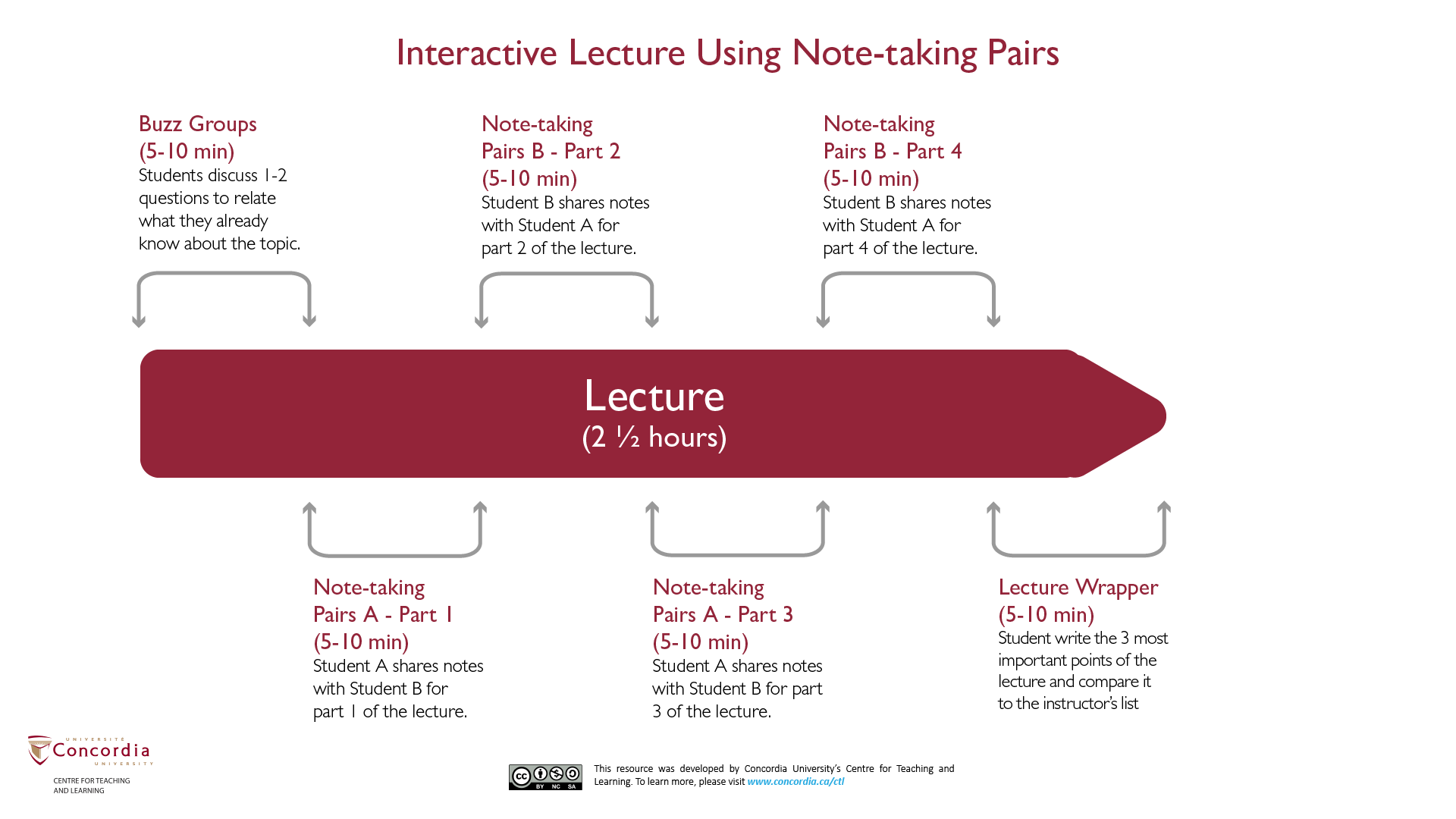
- Buzz Groups (5 – 10 minutes)Students discuss 1-2 questions to relate what they already know about the topic.
- Note-taking Pairs A – Part 1 (5-10 min)
Student A shares notes with Student B for part 1 of the lecture. - Note-taking Pairs B – Part 2 (5-10 min)
Student B shares notes with Student A for part 2 of the lecture. - Note-taking Pairs A – Part 3 (5-10 min)
Student A shares notes with Student B for part 3 of the lecture. - Note-taking Pairs B – Part 4 (5-10 min)
Student B shares notes with Student A for part 4 of the lecture. - Lecture Wrapper (5-10 min)
Students write the 3 most important points of the lecture and compare them to the instructor’s list.
Interactive lecture using peer instruction
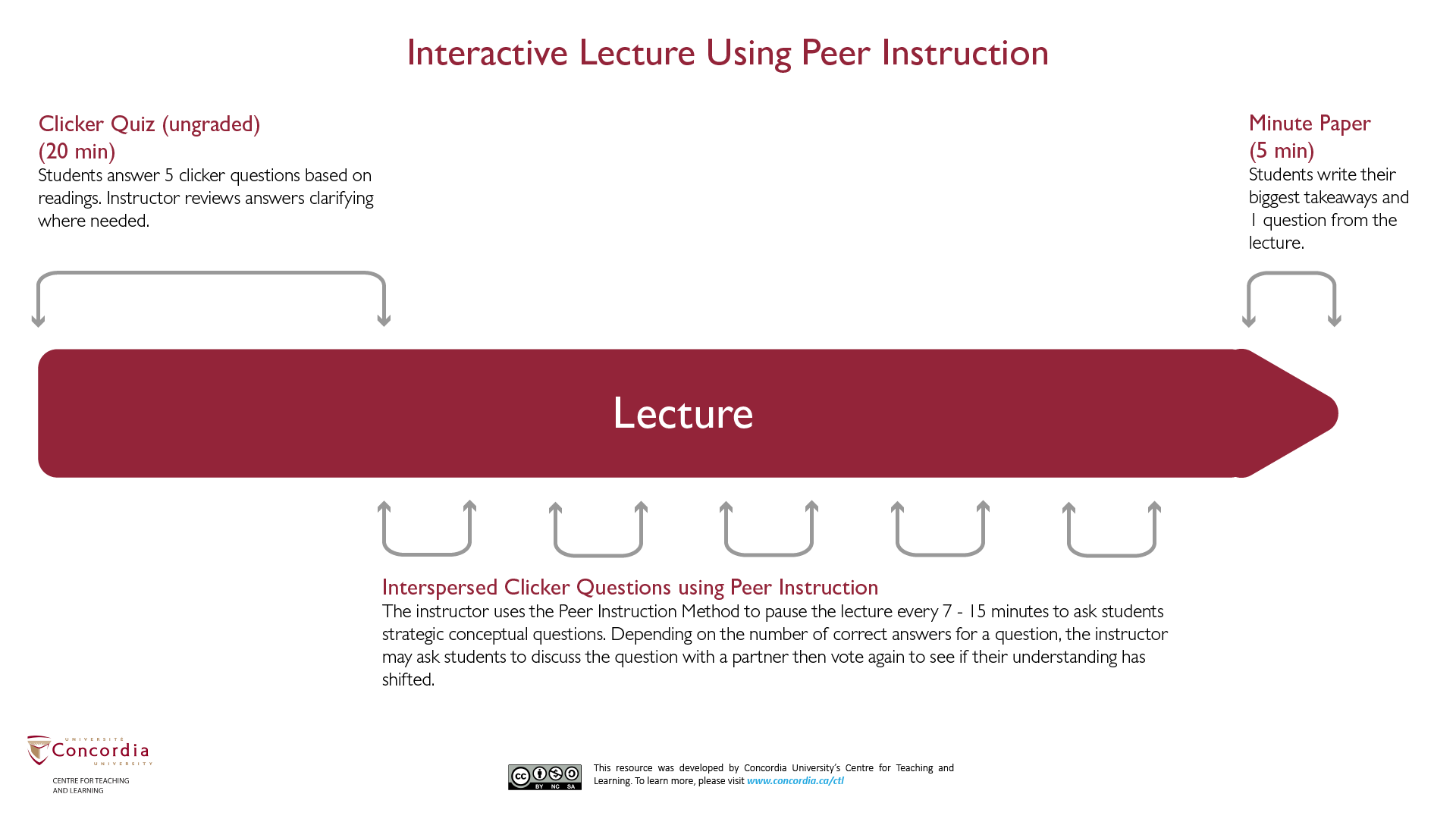
- Clicker Quiz (ungraded; 20 minutes)
Students answer 5 clicker questions based on readings. Instructor reviews answers clarifying where needed. - Interspersed Clicker Questions Using Peer Instruction
The Instructor uses the Peer Instruction Method to pause the lecture every 7 – 15 minutes to ask students strategic conceptual questions. Depending on the number of correct answers to a question, the instructor may ask students to discuss the question with a partner and then vote again to see if their understanding has shifted. - Minute Paper (5 minutes)
Students write their biggest takeaways and 1 question from the lecture.
Active learning with lessons
Some pedagogical approaches, such as the flipped learning approach, don’t require as much lecturing. In this approach, the students spend more class time working through tasks while the instructor circulates and provides clarification when necessary. The students prepare for class in advance by reading or watching videos and come to class ready to consolidate and apply what they learned. Many instructors note the challenge of ensuring students prepare before class to be able to participate actively.
An alternative to the flipped approach would be a model where instructors alternate classes with lectures and an active learning lesson where students practice and apply content from the previous lecture.
The examples below provide examples of what a lesson with less lecturing might look like.
1 – 1.5 hour Active Learning lesson
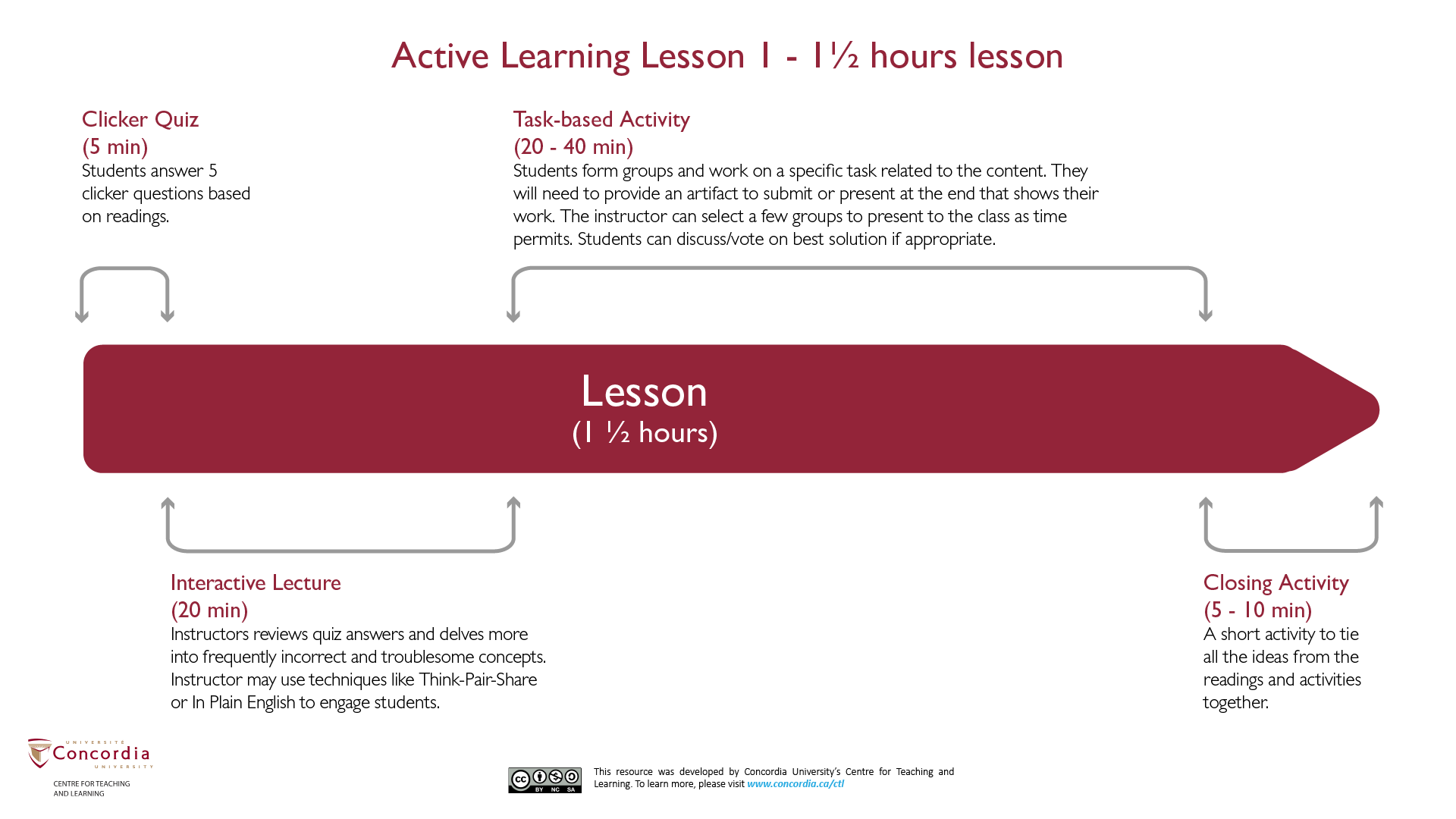
- Clicker Quiz (5 minutes)
Students answer 5 clicker questions based on readings. - Interactive Lecture (20 minutes)
The instructor reviews quiz answers and delves more into frequently incorrect and troublesome concepts. The instructor may use techniques like Think-Pair-Share or In Plain English to engage students. - Task-based Activity (20 – 40 minutes)
Students form groups and work on a specific task related to the concept. They will need to provide an artifact to submit or present at the end that shows their work. The instructor can select a few groups to present to the class as time permits. Students can discuss/vote on the best solution if appropriate. - Closing Activity (5 – 10 minutes)
A short activity to tie all the ideas from the readings and activities together.
2 ½ – 3 hours Active Learning lesson
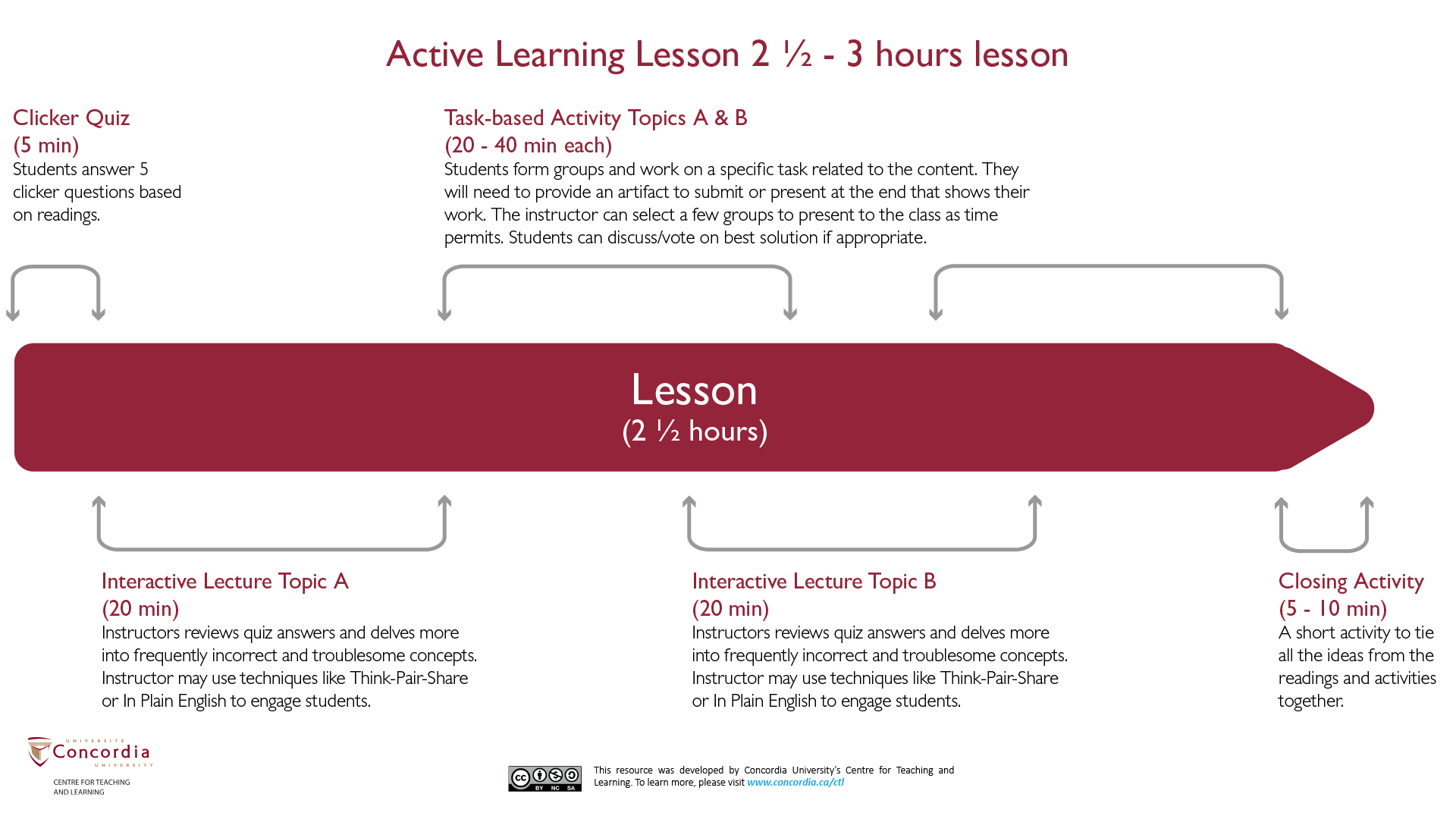
- Clicker Quiz (ungraded; 20 minutes)
Students answer 5 clicker questions based on readings. Instructor reviews answers clarifying where needed. - Interactive Lecture Topic A (20 minutes)
The instructor reviews quiz answers and delves more into frequently incorrect and troublesome concepts. The instructor may use techniques like Think-Pair-Share or in Plain English to engage students. - Task-based Activity Topics A (20 minutes)
Students form groups and work on a specific task related to the concept. They will need to provide an artifact to submit or present at the end that shows their work. The instructor can select a few groups to present to the class as time permits. Students can discuss/vote on best solution if appropriate. - Interactive Lecture Topic B
Students form groups and work on a specific task related to the concept. They will need to provide an artifact to submit or present at the end that shows their work. The instructor can select a few groups to present to the class as time permits. Students can discuss/vote on best solution if appropriate. - Closing Activity (5 – 10 minutes)
A short activity to tie all the ideas from the readings and activities together.
Jigsaw lesson
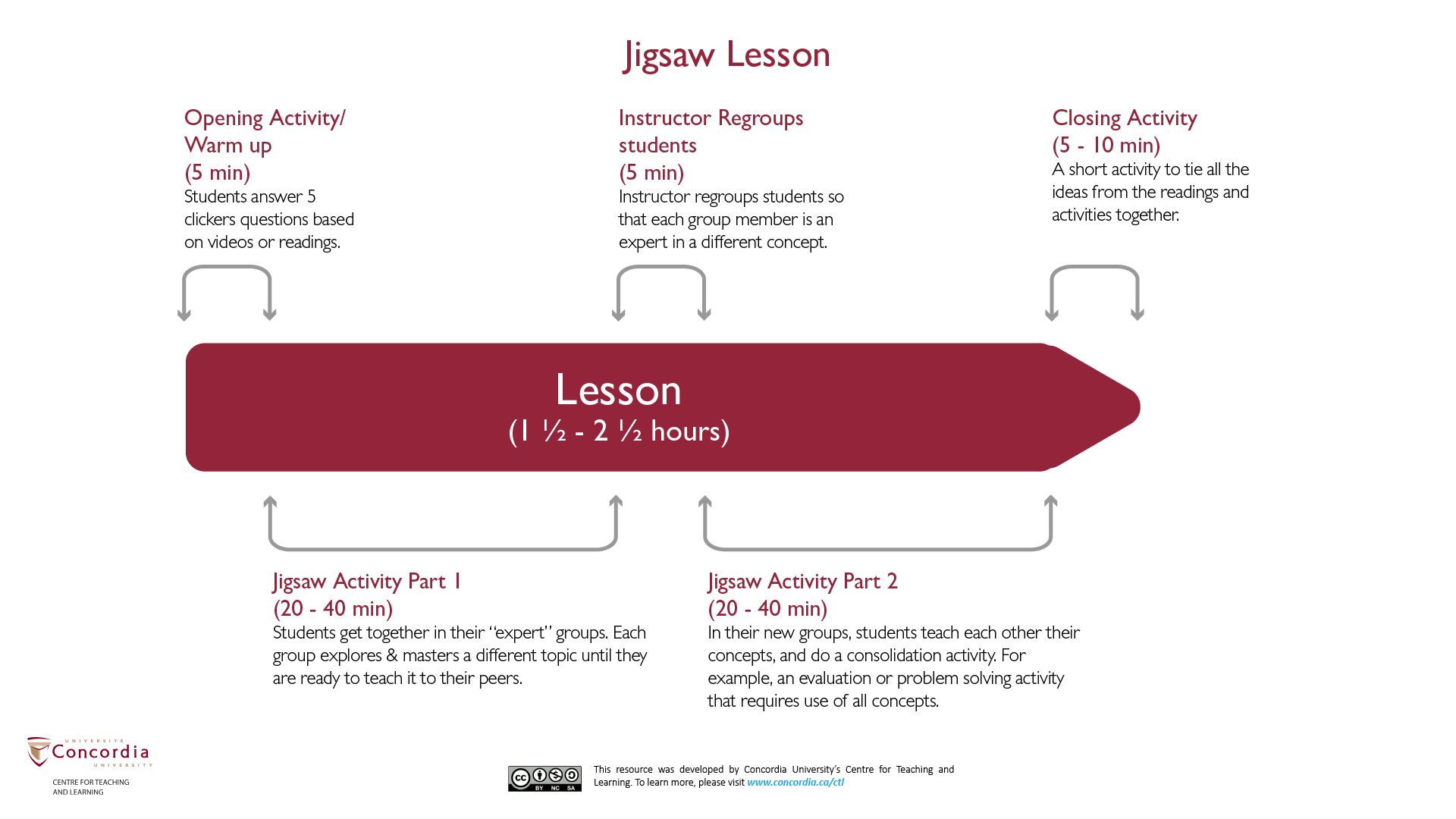
- Opening Activity/Warm up (5 minutes)
Students answer 5 clicker questions based on videos or readings. - Jigsaw Activity Part 1 (20 – 40 minutes each)
Students get together in their “expert” groups. Each group explores & masters a different topic until they are ready to teach it to their peers. - Instructor Regroups Students (5 minutes)
Instructor regroups students so that each group member is an expert in a different concept. - Jigsaw Activity Part 2 (20 – 40 minutes each)
In their new groups, students teach each other their concepts, and do a consolidation activity. For example, an evaluation or problem-solving activity that requires use of all concepts. - Closing Activity (5 – 10 minutes)
A short activity to tie all the ideas from the readings and activities together.

